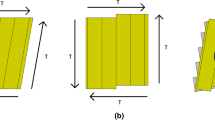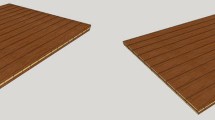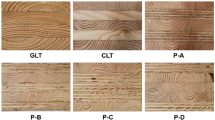Abstract
Different methods, including bending tests and small and medium size shear tests, were used to assess the skin to stringer glue line shear strength of Radiata Pine Cross-Laminated Timber Derived Stressed-Skin Panels (CLT SSP). Bending test shear strengths were estimated using the mechanically jointed beam theory (gamma method) for Cross-Laminated Timber (CLT) panels with modifications in the layers’ effective widths, and then compared with results from the small and medium size shear tests. Small and medium size shear tests proved to be possible methods for assessing bonding strength for factory production control. The small shear tests provided lower strength values and higher scatter results than those gathered from the medium size tests. The mean shear strength results obtained from bending tests were inferior to the values obtained from the small and medium size specimens. The bending tests proved necessary for assessing the mechanical behaviour of CLT SSP.







Similar content being viewed by others
References
APA (2014) Plywood design specification. Supplement 3–12, design and fabrication of plywood stressed-skin panels. Form No. U813M. Tacoma, Washington, USA
Drawsky RH (1960) Stressed-skin panel tests. Laboratory Report No. 82. Douglas Fir Plywood Association (DFPA). Tacoma, Washington, USA
Raadschelders JGM, Blass HJ (1995) Stressed skin panels. STEP 1. Timber engineering. Basis of design, material properties, structural components and joints. Lecture B10, Centrum Hout, Netherlands
Heyer OC, Blomquist RF (1964) Stressed-skin panel performance after twenty five years of service. U.S. Forest Service Research Paper FPL 18, Forest Product Laboratory, U.S Department of Agriculture, Forest Service. Madison, Wisconsin, USA
Möler K, Abdel-Sayed G, Ehlbeck J (1963) Zur berechnung doppelschaliger, geleimter Tafelelemente. Holz als Roh - und Werkstoff 21:328–333
Kuenzi EW, Zahn JJ (1975) Stressed-skin panels deflections and stresses. USDA Forest Service Research Paper FPL 251. Forest Product Laboratory, U.S. Department of Agriculture, Forest Service. Madison, Wisconsin, USA
EOTA (2000) TR 002—technical report no. 2. Test methods for light composite wood-based beams and columns. European Organisation for Technical Assessment—EOTA, Brussels, Belgium
EOTA (2004) ETAG 019, guideline for European technical approval of pre-fabricated wood-based load-bearing stressed skin panels. European Organisation for Technical Assessment, EOTA, Brussels, Belgium
EOTA (2005) TR019—technical report no. 19. Calculation models for prefabricated wood-based load-bearing stressed skin panels for use in roofs. European Organisation for Technical Assessment, EOTA, Brussels, Belgium
EN 1995-1-1 (2004/AC: 2006/A1: 2008/A2: 2014) Eurocode 5. Design of timber structures. Part 1-1: general. Common rules and rules for building. European Committee for Standarization, CEN, Brussels, Belgium
Gagnon S, Popovski M (2011) CLT handbook, Chapter 3—structural design of cross-laminated timber elements. FP innovations Special Publication SP-528E. Quebec, Canada
Blass H, Fellmoser P (2004) Design of solid wood panels with cross layers. In: Proceedings of the 8th world conference on timber engineering (WCTE), vol 2, Lahti, Finland, pp 543–548
Kreuzinger H (1999) Platten, Scheiben und Schalen – ein Berechnungsmodell für gängige statikprogramme. Bauen mit holz 1:34–39
Christovasilis IP, Brunetti M, Follesa M, Nocetti M, Vassallo D (2016) Evaluation of the mechanical properties of cross laminated timber with elementary beam theories. Constr Build Mater 122:202–213
EN 16351 (2015) Timber structures—cross laminated timber—requirements. European Committee for Standarization, CEN, Brussels, Belgium
EN 14080 (2013) Timber structures—glued laminated timber and glued solid timber—requirements. European Committee for Standarization, CEN, Brussels, Belgium
Denzler JK, Glos P (2007) Determination of shear strength values according to EN 408. Mater Struct 40:79–86
UNE 56544 (2011) Clasificación visual de la madera aserrada para uso estructural. Madera de Coníferas (Visual grading for structural sawn timber. Coniferous timber). Asociación Española de Normalización y Certificación, AENOR, Madrid, Spain
EN 1912 (2012) Structural timber. Strength classes. Assignment of visual grades and species. European Committee for Standarization, CEN, Brussels, Belgium
EN 15425 (2008) Adhesives—one component polyurethane for load bearing timber structures—classification and performance requirements. European Committee for Standarization, CEN, Brussels, Belgium
Zanuttini R, Cremonini C (2002) Optimization of the test method for determining the bonding quality of core plywood (blockboard). Mater Struct 35:126–132
EN 13183-2 (2002) Moisture content of a piece of sawn timber—part 2: estimation by electrical resistance method. European Committee for Standarization, CEN, Brussels, Belgium
EN 13183-2 (2002/AC:2003) Moisture content of a piece of sawn timber—part 2: estimation by electrical resistance method. European Committee for Standarization, CEN, Brussels, Belgium
INIA, Instituto Nacional de Investigación y Tecnología Agraria y Alimentaria (1991) Propiedades y Tecnología de la Madera de Pino Radiata del PaísVasco. Monografías INIA núm. 80, INIA
EN 14358 (2016) Timber structures—calculation and verification of characteristic values. European Committee for Standarization, CEN, Brussels, Belgium
EN 338 (2016) Structural timber. Strength classes. European Committee for Standarization, CEN, Brussels, Belgium
Forest Research Institute (1991) Properties and uses of New Zealand Radiata Pine, volume one—wood properties. Section 6.4 and Section 8.3. New Zealand Ministry of Forestry, Forest Research Institute
Forest Products Laboratory (2010) Wood handbook: wood as an engineering material, chap. 5. USDA Forest Service, Madison
Gaspar F, Cruz H, Gomes A (2008) Evaluation of glued laminated timber structures—core extraction and shear testing. In: Proceedings of the world conference on timber engineering (WCTE), Miyazaki, Japan, pp 255–262
Soltis LA, Rammer DM (1994) Shear strength of unchecked glued laminated timber beams. For Prod J 44(1):51–57
Steiger R, Gehri E, Richter K (2010) Quality control of glulam: shear testing of bond lines. Eur J Wood Prod 68:243–256
Ido H, Nagao H, Kato H (2010) Evaluation of shear strength of timber with full scale block shear method. In: Proceedings of the world conference on timber engineering (WCTE), Riva del Garda, Italy, Paper 307, pp 1–8
Betti M, Brunetti M, Lauriola MP, Nocetti M, Ravalli F, Pizzo B (2016) Comparison of newly proposed test methods to evaluate the bonding quality of Cross-Laminated Timber (CLT) panels by means of experimental data and finite element (FE) analysis. Constr Build Mater 125:952–963
Yeh B, Gagnon S, Williamson T, Pirvu C (2012) The cross-laminated timber standard in North America. In: Proceedings of the world conference on timber engineering (WCTE), Auckland, New Zealand, pp 181–182
Steiger R, Arnold M, Risi W (2014) Integrity check of structural softwood glue lines: correspondence between delamination and block shear tests. Eur J Wood Prod 72:735–748
Acknowledgements
AITIM, Madrid, Spain (Technical Research Association for Wood Industries). CIFOR-INIA, Madrid, Spain (Timber Laboratory, National Agricultural Research Institute). Timber Research Group, Universidad Politécnica de Madrid, ayudas líneas de I + D programa de creación y consolidación de Grupos de Investigación Universidad Politécnica de Madrid, 2016. The panels were supplied free of charge by EGOIN SA.
Author information
Authors and Affiliations
Corresponding author
Ethics declarations
Conflict of interest
The authors declare that they have no conflict of interest.
Rights and permissions
About this article
Cite this article
Luengo, E., Hermoso, E., Cabrero, J.C. et al. Bonding strength test method assessment for Cross-Laminated Timber Derived Stressed-Skin Panels (CLT SSP). Mater Struct 50, 204 (2017). https://doi.org/10.1617/s11527-017-1069-8
Received:
Accepted:
Published:
DOI: https://doi.org/10.1617/s11527-017-1069-8




